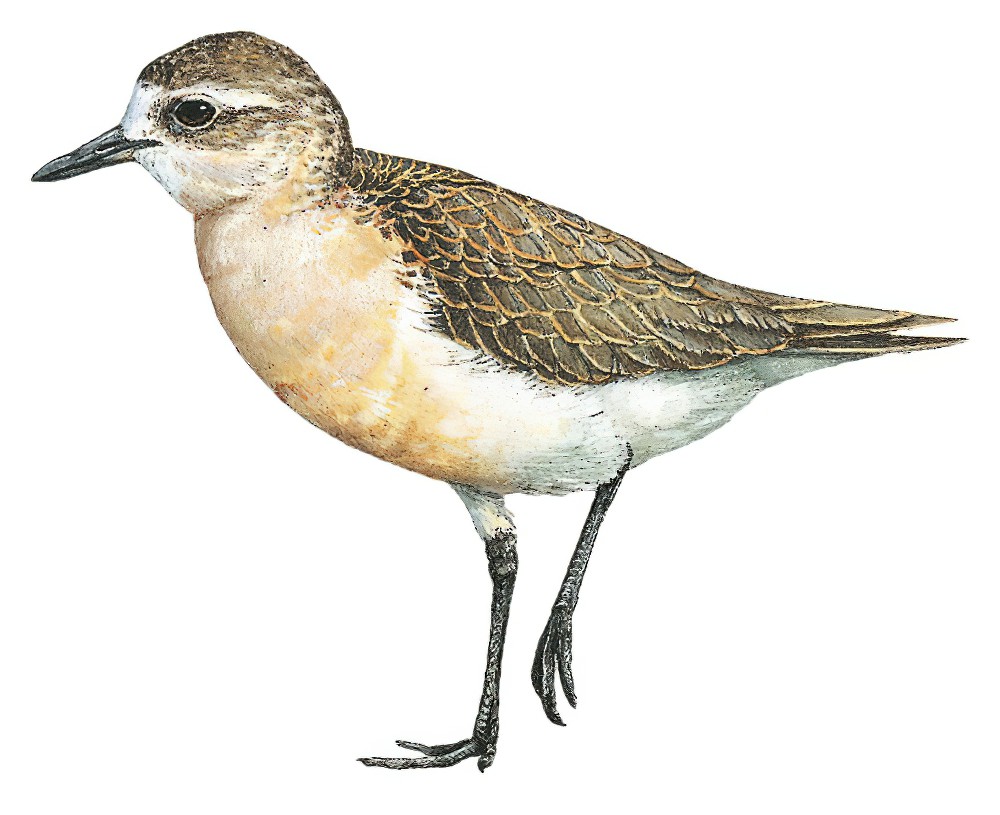Red-breasted Dotterel / Charadrius obscurus

Red-breasted Dotterel
SCI Name:
Protonym: Charadrius obscurus Syst.Nat. 1 pt2 p.686
Taxonomy: Charadriiformes / Charadriidae / Charadrius
Taxonomy Code: rebdot1
Type Locality: New Zealand, i.e. Dusky Sound, South Island, ex Latham.
Author: Gmelin, JF
Publish Year: 1789
IUCN Status:
DEFINITIONS
CHARADRIUS
(Charadriidae; Ϯ Ringed Plover C. hiaticula) Late L. charadrius yellowish bird mentioned in the Vulgate Bible (late 4th century) < Gr. χαραδριος kharadrios unknown plain-coloured nocturnal bird that dwelt in ravines and river valleys < χαραδρα kharadra ravine. According to some authors the sight of it was said to cure jaundice. Early identifications included the Stone-curlew Burhinus oedicnemus; "79. CHARADRIUS. Rostrum teretiusculum, obtusum. Pedes tridactyli." (Linnaeus 1758); "Charadrius Linné, Syst. Nat., ed. 10, 1, 1758, p. 150. Type, by tautonymy, Charadrius hiaticula Linné. (Charadrios s. Hiaticula Aldrovandus, prebinomial specific name in synonymy.)" (Peters, 1934, II, p. 245). Linnaeus's Charadrius comprised eleven species (C. cristatus, C. Hiaticula, C. alexandrinus, C. vociferus, C. ægyptius, C. Morinellus, C. apricarius, C. Pluvialis, C. Oedicnemus, C. Himantopus, C. spinosus).
Var. Charadrias, Charadias.
Synon. Aegialeus, Aegialitis, Aegialophilus, Afraegialis, Afroxyechus, Cirrepidesmus, Eupoda, Eupodella, Helenaegialus, Hiaticula, Hyetoceryx, Leucopolius, Neocharadrius, Nesoceryx, Ochthodromus, Oxyechus, Pagoa, Pagolla, Paroxyechus, Pernettyva, Pipus, Pluviorhynchus, Podasocys, Zonibyx.
obscurum / obscurus
L. obscurus dark, dusky.
● ex “Hook-billed Green Creeper” of Latham 1782 (Akialoa).
● ex “Dusky-crowned Humming-bird” of Latham 1782 (syn. Clytolaema rubricauda).
● ex “Dusky Tody” of Latham 1782, and Pennant 1785 (syn. Contopus virens).
● ex “Pic verd de l’isle de Luçon” of Sonnerat 1776 (syn. Dendropicos griseocephalus).
● ex “Dusky Falcon” of Pennant 1787 (syn. Falco columbarius).
● ex “Dusky Grosbeak” (= ☼) of Pennant, 1784 (syn. Hedymeles ludovicianus).
● ex “Obscure Fly-catcher” of Latham 1823 (syn. Hemipus hirundinaceus).
● "44. PSITTACUS. ... obscurus. 3. P. macrourus niger, genis nudis, vertice cinereo-nigrescente vario, cauda cinerea. Hasselq. iter. 236. Habitat in Africa?" (Linnaeus 1758) (unident.: ?‡syn. Mascarinus mascarin).
● ex “White-rumped Woodpecker” of Latham 1782 (syn. Melanerpes erythrocephalus).
● ex “Tolocatzenatl” of Ray 1713, “Sturnus novae Hispaniae” of Brisson 1760, “Tolcana” of de Buffon 1770-1783, and “Brown-headed Stare” of Latham 1783 (subsp. Molothrus ater).
● ex “Dusky Rail” of Latham 1785 (syn. Pennula sandwichensis).
● ex “Dusky Fly-catcher” of Latham 1783 (Phaeornis).
● ex “Black and White Dobchick” of Edwards 1747, “Colymbus minor” of Brisson 1760, “Petit Grèbe” of d’Aubenton 1765-1781, pl. 942, and “Dusky Grebe” of Pennant 1785, and of Latham 1785 (syn. Podiceps auritus cornutus).
● ex “Dusky Plover” of Latham 1781 (cf. Dusky Bay, New Zealand) (Pluviorhynchus).
● ex “Dusky Petrel” of Latham 1785 (syn. Puffinus assimilis).
● ex “Indian Raven” of Willughby 1676, and “Wreathed Hornbill” of Latham 1781 (syn. Rhyticeros plicatus).
● ex “Dark Thrush” of Latham 1783 (Turdus).
● "This specimen, like many from the Anthony collection, is badly soiled, a condition which may have led Anthony to name a dark race" (Browning 1979) (syn. Vireo huttoni).
● "44. PSITTACUS. ... obscurus. 3. P. macrourus niger, genis nudis, vertice cinereo-nigrescente vario, cauda cinerea. Hasselq. iter. 236. Habitat in Africa ?" (Linnaeus 1758); "Linnæus identified his Psittacus obscurus with P. mascarinus, Briss. ... but the evidence is against this identification" (Salvadori 1891) (unident.; nom. dub.).
SUBSPECIES
Red-breasted Dotterel (Northern)
SCI Name: Charadrius obscurus aquilonius
aquilonius
L. aquilonius northern, of the north < aquilo, aquilonis north wind, north.
Red-breasted Dotterel (Southern)
SCI Name: Charadrius obscurus obscurus
obscurum / obscurus
L. obscurus dark, dusky.
● ex “Hook-billed Green Creeper” of Latham 1782 (Akialoa).
● ex “Dusky-crowned Humming-bird” of Latham 1782 (syn. Clytolaema rubricauda).
● ex “Dusky Tody” of Latham 1782, and Pennant 1785 (syn. Contopus virens).
● ex “Pic verd de l’isle de Luçon” of Sonnerat 1776 (syn. Dendropicos griseocephalus).
● ex “Dusky Falcon” of Pennant 1787 (syn. Falco columbarius).
● ex “Dusky Grosbeak” (= ☼) of Pennant, 1784 (syn. Hedymeles ludovicianus).
● ex “Obscure Fly-catcher” of Latham 1823 (syn. Hemipus hirundinaceus).
● "44. PSITTACUS. ... obscurus. 3. P. macrourus niger, genis nudis, vertice cinereo-nigrescente vario, cauda cinerea. Hasselq. iter. 236. Habitat in Africa?" (Linnaeus 1758) (unident.: ?‡syn. Mascarinus mascarin).
● ex “White-rumped Woodpecker” of Latham 1782 (syn. Melanerpes erythrocephalus).
● ex “Tolocatzenatl” of Ray 1713, “Sturnus novae Hispaniae” of Brisson 1760, “Tolcana” of de Buffon 1770-1783, and “Brown-headed Stare” of Latham 1783 (subsp. Molothrus ater).
● ex “Dusky Rail” of Latham 1785 (syn. Pennula sandwichensis).
● ex “Dusky Fly-catcher” of Latham 1783 (Phaeornis).
● ex “Black and White Dobchick” of Edwards 1747, “Colymbus minor” of Brisson 1760, “Petit Grèbe” of d’Aubenton 1765-1781, pl. 942, and “Dusky Grebe” of Pennant 1785, and of Latham 1785 (syn. Podiceps auritus cornutus).
● ex “Dusky Plover” of Latham 1781 (cf. Dusky Bay, New Zealand) (Pluviorhynchus).
● ex “Dusky Petrel” of Latham 1785 (syn. Puffinus assimilis).
● ex “Indian Raven” of Willughby 1676, and “Wreathed Hornbill” of Latham 1781 (syn. Rhyticeros plicatus).
● ex “Dark Thrush” of Latham 1783 (Turdus).
● "This specimen, like many from the Anthony collection, is badly soiled, a condition which may have led Anthony to name a dark race" (Browning 1979) (syn. Vireo huttoni).
● "44. PSITTACUS. ... obscurus. 3. P. macrourus niger, genis nudis, vertice cinereo-nigrescente vario, cauda cinerea. Hasselq. iter. 236. Habitat in Africa ?" (Linnaeus 1758); "Linnæus identified his Psittacus obscurus with P. mascarinus, Briss. ... but the evidence is against this identification" (Salvadori 1891) (unident.; nom. dub.).
UPPERCASE: current genus
Uppercase first letter: generic synonym
● and ● See: generic homonyms
lowercase: species and subspecies
●: early names, variants, mispellings
‡: extinct
†: type species
Gr.: ancient Greek
L.: Latin
<: derived from
syn: synonym of
/: separates historical and modern geographic names
ex: based on
TL: type locality
OD: original diagnosis (genus) or original description (species)












